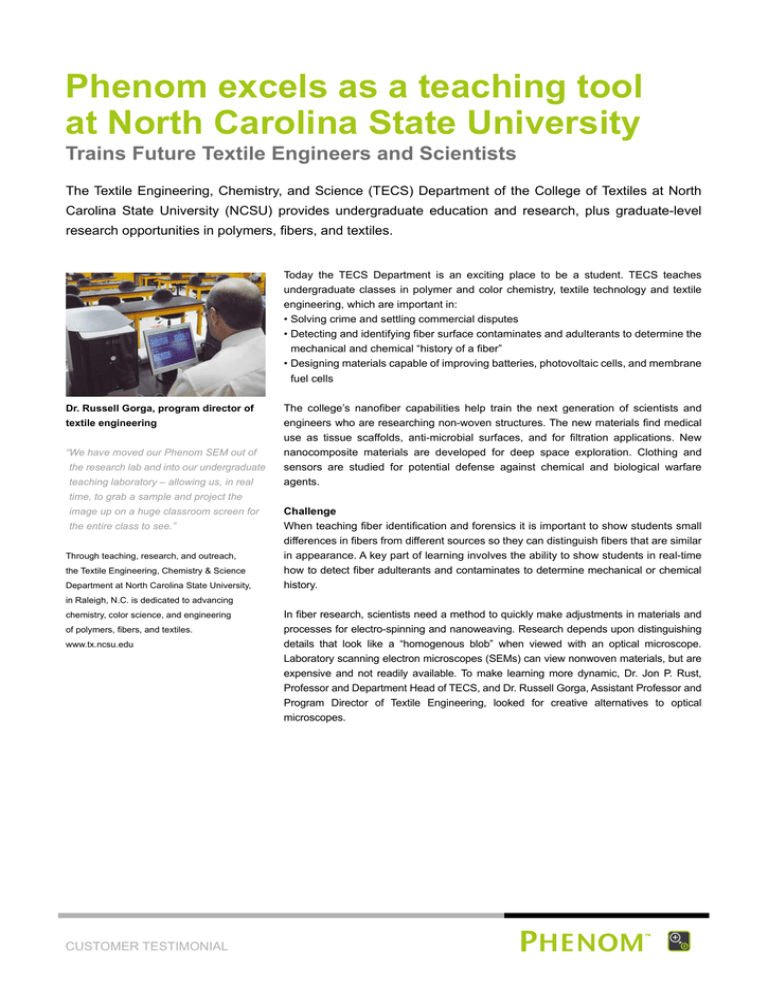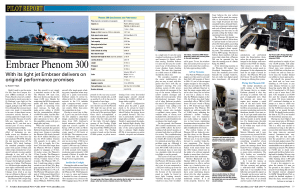
Phenom excels as a teaching tool
at North Carolina State University
Trains Future Textile Engineers and Scientists
The Textile Engineering, Chemistry, and Science (TECS) Department of the College of Textiles at North
Carolina State University (NCSU) provides undergraduate education and research, plus graduate-level
research opportunities in polymers, fibers, and textiles.
Today the TECS Department is an exciting place to be a student. TECS teaches
undergraduate classes in polymer and color chemistry, textile technology and textile
engineering, which are important in:
• Solving crime and settling commercial disputes
• Detecting and identifying fiber surface contaminates and adulterants to determine the
mechanical and chemical “history of a fiber”
• Designing materials capable of improving batteries, photovoltaic cells, and membrane
fuel cells
Dr. Russell Gorga, program director of
textile engineering
“We have moved our Phenom SEM out of
the research lab and into our undergraduate
teaching laboratory – allowing us, in real
The college’s nanofiber capabilities help train the next generation of scientists and
engineers who are researching non-woven structures. The new materials find medical
use as tissue scaffolds, anti-microbial surfaces, and for filtration applications. New
nano­composite materials are developed for deep space exploration. Clothing and
sensors are studied for potential defense against chemical and biological warfare
agents.
time, to grab a sample and project the
image up on a huge classroom screen for
the entire class to see.”
Through teaching, research, and outreach,
the Textile Engineering, Chemistry & Science
Department at North Carolina State University,
Challenge
When teaching fiber identification and forensics it is important to show students small
differences in fibers from different sources so they can distinguish fibers that are similar
in appearance. A key part of learning involves the ability to show students in real-time
how to detect fiber adulterants and contaminates to determine mechanical or chemical
history.
in Raleigh, N.C. is dedicated to advancing
chemistry, color science, and engineering
of polymers, fibers, and textiles.
www.tx.ncsu.edu
CUSTOMER TESTIMONIAL
In fiber research, scientists need a method to quickly make adjustments in materials and
processes for electro-spinning and nanoweaving. Research depends upon distinguishing
details that look like a “homogenous blob” when viewed with an optical microscope.
Laboratory scanning electron microscopes (SEMs) can view nonwoven materials, but are
expensive and not readily available. To make learning more dynamic, Dr. Jon P. Rust,
Professor and Department Head of TECS, and Dr. Russell Gorga, Assistant Professor and
Program Director of Textile Engineering, looked for creative alternatives to optical
microscopes.
Trilobal:
Trilobal nylon:
Trilobal wideangle:
Trilobal closeup:
optical image at 400x
optical image at 100x
Phenom at about 400x
Phenom at about 2500x
“We needed to show students details about natural and synthetic
fibers that you are not able to see using optical microscopes.”
The Solution
The Phenom is rugged, has a quick sample load time, with
resolution to 30 nm. “We were able to install it in the classroom
and use it as an amazing teaching tool,” says Rust.
In fiber identification and forensics, “We get great high-resolution
images of natural and man-made fibers – you see many details
with the Phenom that you aren’t able to see with an optical
microscope,” says Rust. “For instance, scales on human hair are
difficult for many students to discern using an optical microscope
and are easily seen using the Phenom.”
The Phenom allows students to distinguish small differences in
fibers, allowing identification of different sources, and detection
of adulterants or contaminates. The Phenom can also help
determine the mechanical or chemical history of a particular fiber
– important in solving a crime or resolving a commercial dispute.
In electro-spinning research applications, the NC State College
of Textiles uses the Phenom to see “if we are getting nice uniform
(nano) fibers.” Non-woven structures mimic body cell production
in terms of laying down structures that are useful for making
tissue scaffolds and anti-microbial surfaces - also used for
filtration type applications. “The Phenom is a great way for my
graduate students to quickly view what is going on when we are
making different changes to materials and to the process. The
Phenom allows us to quickly see if we are producing a fiber
structure or not,” says Gorga.
The Result
“The story is as simple as one, two, three,” concludes Rust.
“One, the Phenom has improved undergraduate education by
taking the SEM out of the lab and putting it into the classroom for
an entire class to see. Magnifications at 7000x, provide aweinspiring moments for all our students. Two, the Phenom
benefited our forensics program by not having to bear the
expense of a traditional lab SEM. And, three, the Phenom
improved the efficiency of research by allowing our students to
walk out of our nonwoven production facility and be able to
check a sample immediately and not have to wait until next week
to schedule a lab SEM.”
Where will TECS’s students go next? Perhaps they will develop
artificial organ tissue, design clothing to repel chemical and
biological contamination, or engineer the next revolution in
membrane fuel cells. Whatever careers these TECS students
choose, their learning curve is accelerated by the Phenom.
Phenom-World BV, Dillenburgstraat 9E, 5652 AM Eindhoven, The Netherlands,
Netherlands www.phenom-world.com
©2011. Specifications and prices are subject to change without notice. All rights reserved. Reproduction, copying, usage,
modifying, hiring, renting, public performance, transmission and/or broadcasting in whole or in part is prohibited without the
written consent of Phenom-World BV. Find your Phenom-World contact information at www.phenom-world.com
CT00505WW v1.0
Why Phenom™
NCSU chose Phenom™ because it is compact, efficient, and
cost-effective. “It increases what you can do in the classroom –
like change samples quickly – creating immediate ‘teachable
moments’ for students,” says Gorga. “We project the Phenom’s
images in real-time via overhead projector to a huge screen,
which you can’t do using a delicate lab SEM.”
“We teach fiber identification. We have some very nice optical
microscopes but the problem is they only take you so far. We
wanted to expand our range of magnification from hundreds of
times magnification with the optical microscopes, and go up to
thousands of times magnification range with the Phenom SEM,”
says Gorga.





